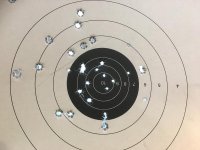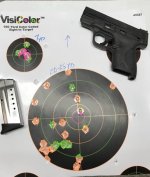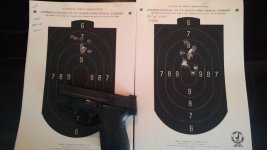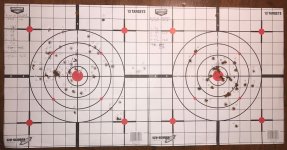You are using an out of date browser. It may not display this or other websites correctly.
You should upgrade or use an alternative browser.
You should upgrade or use an alternative browser.
Shield Accuracy
- Thread starter Chacam
- Start date
Register to hide this ad
jakebrake
Member
"how accurate is a shield?" is like asking "how fast is a car?".. a ton of variables. first off, a shield is a defense pistol. at 16 yards, You definitely put a hurtin in whoever was coming at you.
also, turning the target right side up might help (http://smith-wessonforum.com/images/smilies/biggrin.gif). You seem to be consistent with where You're hitting (one side) adjust from there.
also, turning the target right side up might help (http://smith-wessonforum.com/images/smilies/biggrin.gif). You seem to be consistent with where You're hitting (one side) adjust from there.
The Shield is a good shooter....
But like any light, compact pistol it takes some practice to be able to shoot it well. And it's still a defense pistol. 50' is a long shot for most defensive shooting. If you can move the group to center and get most of the shots in an 8" circle you should be good to go for SD purposes.
The Shield is so much fun to shoot that I get plenty of practice.
But like any light, compact pistol it takes some practice to be able to shoot it well. And it's still a defense pistol. 50' is a long shot for most defensive shooting. If you can move the group to center and get most of the shots in an 8" circle you should be good to go for SD purposes.
The Shield is so much fun to shoot that I get plenty of practice.
9mm shield, 147 gr lead round nose over 3 gr Titegroup. I can generally keep them in a 7” group at 50 feet offhand with stock sights. Is this a typical group size at this distance? Just a touch high and left. I think I can do better. The small holes are .22lr. Thanks for any comments.
View attachment 366086
Are you wanting to see how well you shoot or how accurate your pistol is? If the latter, shoot from rest, not offhand. My shield will put all shots in IDPA target head in my hands at 10yd-4 inch circle- about half that from rest
Funflyer
Member
Between my two Shields, the 45 was a target pistol compared to the 9 until I started reloading. Using .356 coated bullets made a remarkable improvement in accuracy over any factory FMJ. Slugging the 9's barrel, I measured it at .3545" and factory ammo was averaging .354", with many at .3535" so, there was my answer as to why. Firing my reloads from 15 yards, I can easily achieve 3" groups from a rest and around 4" off hand.
I load 115gn coated LRN with 4.8gn of HP38
I load 115gn coated LRN with 4.8gn of HP38
Last edited:
Ranger17
Member
I am not a great shot, but I enjoy shooting. With my Pc Shield i can normally do pretty well in the 6-10 yard area. At an outdoor range just for giggles i tried it at 20-25 yards. Guess all things considerd from short barrel to grandpa eyes to my skill set it wasn't too bad. Pic compares that day’s results from 7yd to the longer distances.
Point being a decent shooter can do well with the Shield. I bet in the hands of someone with real skill it would do even better.
Edit I only use 115gn ammo.
Point being a decent shooter can do well with the Shield. I bet in the hands of someone with real skill it would do even better.
Edit I only use 115gn ammo.
Attachments
Last edited:
...My shield will put all shots in IDPA target head in my hands at 10yd-4 inch circle- about half that from rest
I suspect this is pretty close to what I get with my 9mm Shield with the usual FMJ 115-124 grain stuff I have lying around. I’ve never tried 147 grain ammo in it. I rarely shoot the gun at more than 35 feet. I intend to start stretching that some this winter.
I don't shoot my Shield 9 too much these days since I got my Shield .45. They both have about 4,500 rounds through them, but I prefer my Shield .45 because it is more accurate for me. I've attached photos of my most recent targets for both. I calculate an accuracy score, which is the percentage of shots that hit in the 4"x4" square in the center of the 12"x12" target. Both targets were at 15 yards. The Shield 9 target is on the left. At that distance, I'm ecstatic if I put 50% of my Shield 9 shots into the 4x4 square. With my Shield .45, I'm not really happy unless it's over 60%. The pictured result for the 9 is fairly typical, but the result for the .45 represents a really good shoot for me. If it had been really lousy, I wouldn't have posted!
Attachments
If I'm shoot targets......
If I'm shooting for target accuracy, a very slow147 gr SWC with Acc #7 has given me the best accuracy to the point where I surprised myself.
If I'm shooting for target accuracy, a very slow147 gr SWC with Acc #7 has given me the best accuracy to the point where I surprised myself.
Ranger17
Member
From my experiences, not to mention those here who post as well.... I would say the Shield can be quite accurate all things considered. It isnt a ‘target’ gun yet we can get good results at the range with one. Heck I’ve never even tried shooting mine (or any other gun for that matter) from a rest. And I only shoot 115, tried 124 but that seemed to get the same results though never tried 147. Maybe I will sometime.
So the expectations for any Shield owner should be reasonable to work towards.
So the expectations for any Shield owner should be reasonable to work towards.
"how accurate is a shield?" is like asking "how fast is a car?".. a ton of variables.
Some of my pistols are more accurate than others.
I don't shoot the 9mm Shield as well as the 45. It might be the slightly smaller size makes a bigger difference that one would think.
9mm at 25' with its favorite ammo

9mm at 25' with the other brands

The 45 Shield is a lot less finicky.

Last summer we had a good time on the on the steel with our carry guns. I was surprised how well the 45 Shield did. At 100 yards I could put at least half the magazine on a 12 x 18 plate. The ratio went down the farther out we went, but man was that fun and two of the other guys went out and bought 45 Shields afterwards. Here is some 400 yard video. The holdover required lob those 230 grain projectiles in made it very challenging.
[ame="https://www.youtube.com/watch?v=omZt2DMZFbI"]https://www.youtube.com/watch?v=omZt2DMZFbI[/ame]
9mm at 25' with its favorite ammo

9mm at 25' with the other brands

The 45 Shield is a lot less finicky.

Last summer we had a good time on the on the steel with our carry guns. I was surprised how well the 45 Shield did. At 100 yards I could put at least half the magazine on a 12 x 18 plate. The ratio went down the farther out we went, but man was that fun and two of the other guys went out and bought 45 Shields afterwards. Here is some 400 yard video. The holdover required lob those 230 grain projectiles in made it very challenging.
[ame="https://www.youtube.com/watch?v=omZt2DMZFbI"]https://www.youtube.com/watch?v=omZt2DMZFbI[/ame]
max503
Member
My friends 9mm Shield is amazingly accurate.
The average Shield has average accuracy potential. It’s a mass manufactured gun with a range of acceptable manufacturing tolerances. What’s average? S&W knows, but they aren’t telling.
So we share our experiences about our perception of our gun and how we shoot it, and what we have done to improve the overall accuracy of the gun and our shooting of it. With all the variables present and accounted for, our comparisons are not themselves really accurate.
Nonetheless, such anecdotal tales of holes in paper are fun to read and do produce a nugget or two—like slugging the bore to handload the perfect bullet (Wow! Wonderful!) over the most accurate charge of powder.
So, my contribution is that I have sunk a lot of money into my Shield to make it more accurate. I didn’t need to, I wanted to. It’s a hobby with a goal: have the most reliable fast and accurate shooting CCW I can. It’s gives me a little extra confidence in the gun, knowing it is about maximized for its potential, and that puts the pressure on me to perform better with it.
Shield 1.0 with a milled Shield RMS Red Dot, Apex flat faced trigger and other fire control components, True Precision extended barrel (tight fit), Heine Straight Eight nite sites co-witnessed, and a grip enhancement of dribbled epoxy (Cerakoted).
At five yards two-handed, slow fire, I can hit the eye socket of a human photo target every time when I do my part. At this range, the gun is at least 1” accurate. Out to 15 yards I can hit the eye-nose box of the same target (3”). At 20 yards I can keep all shots centered—slow fire—in the upper chest with a sub 4” group. That gives me the confidence I want to carry this gun once in a while when I don’t carry my larger, more accurate and easier to shoot full size M&P.

Target photos to follow soon. Thanks gwmac for the Photobucket update.
So we share our experiences about our perception of our gun and how we shoot it, and what we have done to improve the overall accuracy of the gun and our shooting of it. With all the variables present and accounted for, our comparisons are not themselves really accurate.
Nonetheless, such anecdotal tales of holes in paper are fun to read and do produce a nugget or two—like slugging the bore to handload the perfect bullet (Wow! Wonderful!) over the most accurate charge of powder.
So, my contribution is that I have sunk a lot of money into my Shield to make it more accurate. I didn’t need to, I wanted to. It’s a hobby with a goal: have the most reliable fast and accurate shooting CCW I can. It’s gives me a little extra confidence in the gun, knowing it is about maximized for its potential, and that puts the pressure on me to perform better with it.
Shield 1.0 with a milled Shield RMS Red Dot, Apex flat faced trigger and other fire control components, True Precision extended barrel (tight fit), Heine Straight Eight nite sites co-witnessed, and a grip enhancement of dribbled epoxy (Cerakoted).
At five yards two-handed, slow fire, I can hit the eye socket of a human photo target every time when I do my part. At this range, the gun is at least 1” accurate. Out to 15 yards I can hit the eye-nose box of the same target (3”). At 20 yards I can keep all shots centered—slow fire—in the upper chest with a sub 4” group. That gives me the confidence I want to carry this gun once in a while when I don’t carry my larger, more accurate and easier to shoot full size M&P.

Target photos to follow soon. Thanks gwmac for the Photobucket update.
Last edited:
gwmac
Member
As an aside, Photobucket is back and free.
I absolutely love my 9mm Shields  Started with version 1 and it is very accurate..Purchashed a M2 earlier in the year and have used it at two defensive courses, and plenty of general range shooting; it is extremely accurate!!
Started with version 1 and it is very accurate..Purchashed a M2 earlier in the year and have used it at two defensive courses, and plenty of general range shooting; it is extremely accurate!!
It is my everyday carry and at what would be considered normal self defense range (15 yards or less) I feel as confident, if not more confident than shooting my M&P full-size..
The Shield fits me perfect and I am sure that contributes to the accuracy and confidence I have with it
It is my everyday carry and at what would be considered normal self defense range (15 yards or less) I feel as confident, if not more confident than shooting my M&P full-size..
The Shield fits me perfect and I am sure that contributes to the accuracy and confidence I have with it
FloridaS&W
Member
- Joined
- Sep 27, 2015
- Messages
- 307
- Reaction score
- 353
The Shield 45 is above average in accuracy. Several of us have found it to be more accurate than other Shield models. I don't know why but it just is.The average Shield has average accuracy potential. It’s a mass manufactured gun with a range of acceptable manufacturing tolerances. What’s average? S&W knows, but they aren’t telling....
Rastoff
US Veteran
Just out of curiosity, what is average accuracy for a .45ACP gun?The Shield 45 is above average in accuracy.
Similar threads
- Replies
- 1
- Views
- 115
- Replies
- 42
- Views
- 4K
- Replies
- 25
- Views
- 1K




